We have given these Class 12 Biology Important Questions Chapter 2 Sexual Reproduction in Flowering Plants to solve different types of questions in the exam. Go through these Class 12 Biology Chapter 2 Important Questions, Sexual Reproduction in Flowering Plants Important Questions & Previous Year Questions to score good marks in the board examination.
Class 12 Biology Chapter 2 Important Questions Sexual Reproduction in Flowering Plants
Question 1.
Angiosperms bearing unisexual flowers are said to be either monoecious or dioecious. Explain with the help of one example each. (All India 2016)
Answer:
Plant bearing flowers of both sexes, i.e. staminate and pistillate flowers called monoecious, e.g. lea mays (maize).
When both sexes, i.e. staminate and pistillate flowers, are present on different plants; these plants are called dioecious, e.g. Carica papaya (Papaya).
![]()
Question 2.
These pictures show the gynoecium of (A) Papaver and (B) Michelia flowers. Write the difference in the structure of their ovaries. (Delhi 2015C)
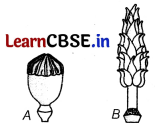
Answer:
The gynoecium of Papaver is multicarpellary and syncarpous (pistils are fused together), the ovary can be unilocular to multilocular. The gynoecium of Michelia is multicarpellary and apocarpus (pistils are free) and the ovary is always unilocular.
Question 3.
Name the parts of the flower which the tassels of corn cob represent. (All India 2014)
Answer:
The parts of the flower that represent the tassels of corn cob are stigma and style which wave in the wind to trap pollen grains flowing with the wind.
Question 4.
Draw a diagram of a mature microspore of an angiosperm. Label its cellular components only. (Foreign 2014)
Or
Draw a labelled diagram of at mature pollen grain. (Delhi 2013C)
Answer:
The labelled diagram of a mature microspore of an angiosperm with its cellular components is given below
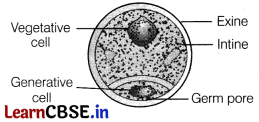
Question 5.
State the function of filiform apparatus found in mature embryo sac of an angiosperm. (Foreign 2014)
Answer:
The special cellular thickenings present in synergids at the micropylar tip called filiform apparatus, found in mature embryo sac of an angiosperm help in guiding the entry of pollen tubes up to the synergids.
Question 6.
Give an example of a plant which came into India as a contaminant and is a cause of pollen allergy. (All India 2014)
Answer:
Parthenium or Carrot grass is a major contaminant which came to India and caused pollen allergy.
Question 7.
A bilobed, dithecous anther has 100 microspore mother cells per microsporangium. How many male gametophytes this anther can produce? (Delhi 2010)
Answer:
An anther is a four-sided (tetragonal) structure consisting of four microsporangia.
Each microsporangium has 100 microspore
mother cells, so total number of microspore
mother cells in anther = 4 × 100 = 400
microspore mother cells. Meiosis in each microspore mother cell produces 4 male gametes, so 400 cells will produce = 4 × 400 = 1600 male gametes.
Question 8.
An anther with malfunctioning tapetum often fails to produce viable male gametophytes. Give one reason. (Delhi 2010)
Or
Write the function of tapetum in anthers. (Delhi 2012)
Answer:
The anther with malfunctioning tapetum cannot provide complete nutrition to the developing microspores or male gametophytes. So, it fails to produce viable male gametophyte.
Question 9.
In the TS of a mature anther given below, identify ‘a’ and ‘b’ and mention their functions. (All India 2019)
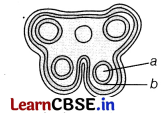
Answer:
In the given figure, a is sporogenous tissue and b is tapetum.
- Sporogenous tissue has cell which are potential Pollen Mother Cell (PMC) or microspore mother cell and give rise to microspore tetrad after meiotic cell division.
- Tapetum nourishes the developing microspores or pollen grains.
Question 10.
A pollen grain in angiosperm at the time of dehiscence from an anther could be 2-celled or 3-celled. Explain, how are the cells placed within the pollen grain when shed at a 2-celled stage? (All India 2017)
Answer:
A pollen grain is partly germinated microspore representing the male gametophyte. It divides by unequal mitotic division and forms two cells. Thus, each mature pollen grain in angiosperms have a generative cell and a vegetative cell.
In about 60% of angiosperms, pollen grains are shed at this 2-celled stage. However, in about 40% flowering plants, the generative cell may further divide mitotically to give rise to two male gametes and pollen grains are shed at this 3-celled stage.
The placement of cells within the pollen grain when shed at 2-celled stage can be visualised as shown below
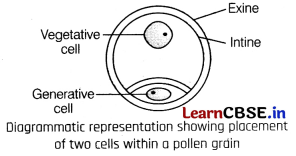
Question 11.
A mature embryo sac in a flowering plant may possess 7-cells, but 8-nuclei. Explain with the help of a diagram only. (Delhi 2017)
Answer:
A typical angiospermic embryo sac is 8-nucleated and 7-celled.
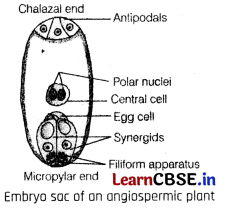
Question 12.
In a flowering plant, a microspore mother cell produces four male gametophytes while a megaspore mother cell forms only one female gametophyte. Explain. (Delhi 2017)
Answer:
In flowering plants, microspore mother cells are found embedded in the spOrophytic tissue of anther. These cells undergo meiosis and give rise to four microspores that remain together in a microspore tetrad. After attaining maturity, these microspores separate from each other and each microspore develops into a male gametophyte or pollen grain.
On the other hand, megaspore mother cell develops in the ovary of a flower and divides by meiotic division to produce four megaspores. From these, three degenerate while, the one undergoes further development and mitotic divisions to produce female gametophyte. Thus, in a flowering plant, a microspore mother cell produces four male gametophytes while, megaspore mother cell produces one female gametophyte.
Question 13.
Gynoecium of a flower may be apocarpous or syncarpous. Explain with the help of an example each. (Delhi 2016)
Answer:
Gynoecium of a flower is called as apocarpous when the carpels are free, e.g. apocarpus in Ranunculus. Whereas it is called syncarpous when the carpels are fused, e.g. syncarpous in Petunia.
![]()
Question 14.
Draw a diagram of a section of a megasporangium of an angiosperm and label funiculus, micropyle, embryo sac and nucellus. (All India 2016)
Answer:
Diagrammatic view of a megasporangium and pollen grains are shed at this 3-celled stage. (anatropous ovule)
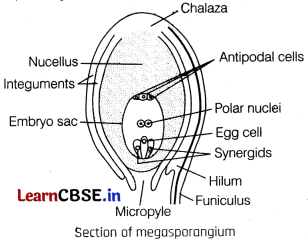
Question 15.
Differentiate between the two cells enclosed in a mature male gametophyte of an angiosperm. (All India 2013)
Answer:
Haploid pollen grains represent the male gametophyte. It contains two cells, i.e. vegetative cell and generative cell.
The vegetative or tube cell is larger in size as compared to generative cell and have a vacuolated cytoplasm. The generative cell on the other hand have thin dense cytoplasm with prominent nuclei that give rise to two male gametes, while vegetative cell does not.
Question 16.
Name all the haploid cells present in an unfertilised mature embryo sac of a flowering plant. Write the total number of cells in it. (All India 2013)
Or
How many haploid cells are present in mature female gametophyte of a flowering plant? Name them. (Delhi 2013C)
Answer:
An unfertilised embryo sac of angiosperm is composed of 7 cells, i.e. 7-celled and 8-nucleated. Among 8-nuclei, 6 are enclosed by cell walls and organised into cells, which are haploid in number (3 antipodals, 2 synergids and 1 egg cell) and a large central cell with 2 polar nuclei.
Question 17.
Draw a labelled schematic diagram of the transverse section of a mature anther of an angiosperm plant. (Delhi 2013)
Answer:
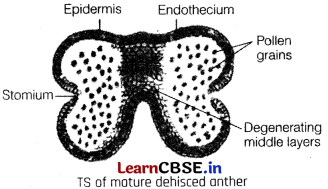
Question 18.
Explain the function of germ pores. (All India 2012 )
Answer:
Germ pores are prominent apertures of pollen grain exine where sporopollenin is absent. These are the regions where intine comes out forming a pollen tube to release male gamete in the embryo sac.
Question 19.
Identify and label the parts in the given anatropous ovule. (All India 2010C)
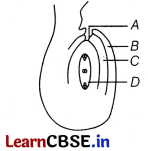
Answer:
A – Micropyle B – Outer integument
C – Inner integument D – Embryo sac
Question 20.
Pollen banks are playing a very important role in promoting plant breeding programme the world over.
How are pollens preserved in the pollen banks? Explain. How are such banks benefitting our farmers? Write any two ways. (Delhi 2019)
Answer:
Pollen grains are stored for years in liquid nitrogen (-196°C) in pollen banks for later use in plant breeding programmes. Plant breeding is a technique of manipulation of plant species in order to create desired plant types that are better suited for cultivation, give better yield and are disease resistant.
The objectives of such pollen banks include incorporation of certain traits or characters into crop plants in order to enhance the food production such as
(i) Increased tolerance to environmental stresses such as salinity, extreme temperature, drought, etc.
(ii) Resistance to pathogens like viruses, fungi and bacteria.
Question 21.
(i) Name the organic material exine of the pollen grain is made up of. How is this material advantageous to pollen grain?
(ii) Still it is observed that it does not form a continuous layer around the pollen grain. Give reason.
(iii) How are ‘pollen banks’ useful? (All India 2016C)
Answer:
(i) The organic material of exine of pollen grain is sporopollenin. This is most resistant biological material known so far. It protects pollen grains from damages.
(ii) Exine on pbllen grain is not a continuous layer. It is thin at places and pollen tube germinates by growth of intine through these thin parts of exine called germ pores.
(iii) Pollen banks are used to store pollen grains for short as well as long period of time in viable conditions.
Question 22.
Draw a labelled diagram of a section of an enlarged view of microsporangium of an angiosperm. (All India 2016C)
Or
Why are angiosperm anthers called dithecous? Describe the structure of its microsporangium. (Delhi 2014)
Or
Describe the structure of a mature microsporangium of an angiosperm. (Delhi 2014)
Answer:
The structure of a mature microsporangium can be described with the help of given diagram.
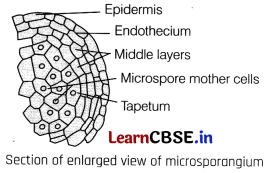
Since, the angiosperm’s anthers are bilobed, each lobe bearing two thecae, they are referred to as dithecous. Microsporangium appears circular in outline and is usually surrounded by four wall layers. The outer three layers epidermis, endothecium and middle layers are protective in function. They also help in dispersal of pollens by dehiscing themselves. While, the innermost layer tapetum is nutritive in function and nourishes the developing pollen grdins. The centre of the microsporangium comprises of compact
sporogenous tissue. The cells of this sporogenous tissue undergo meiotic divisions to form microspore tetrads, that further develop to form pollen grains.
Question 23.
Draw a labelled diagram of a typical anatropous ovule. (Delhi 2014)
Answer:
For structure or labelled diagram of anatropous ovule,
Refer to Answer No. 14.
Question 24.
Explain the process of microsporogenesis in angiosperms. (Delhi 2013C)
Answer:
The formation of microspores from a pollen mother cell through meiosis is called microsporogenesis.
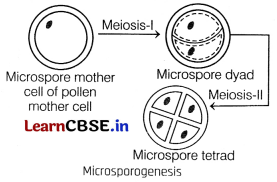
Microspores are arranged as tetrad. As the anthers mature and dehydrate they dissociate from each other and develop into mature pollen grains. Pollen grains or the male gametophytes are released by dehiscence of anther.
Question 25.
Draw a diagram of a mature embryo sac of an angiosperm and label the following parts in it. (Delhi 2013)
(i) Filiform apparatus
(ii) Synergids
(iii) Central cells
(iv) Egg cell
(v) Polar nuclei
(vi) Antipodals
Answer:
For mature embryo sac of angiosperm, Refer to figure in Answer No. 11.
![]()
Question 26.
Explain the process of megasporogenesis in angiosperms. (Delhi 2013C)
Or
Trace the development of megaspore mother cell up to the formation of a mature embryo sac in a flowering plant. (Delhi 2012)
Answer:
The process of formation of megaspores from the megaspore mother cell (2n) by the meiosis division in the ovule is called megasporogenesis. Refer to Answer No. 28.
Question 27.
Describe the structure of a 3-celled pollen grain of an angiosperm. (Delhi 2012C)
Answer:
The 3-celled pollen grain structure in an angiosperm consists of two male gametes and one vegetative cell. The vegetative cell is bigger, has abundant food reserve and a large irregularly-shaped nucleus. The generative cell is small and floats in the cytoplasm of the vegetative cell. It is spindle-shaped with dense cytoplasm and a nucleus. In over 60% of angiosperms, pollen grains are shed at this 2-celled stage. In most of the angiospermic species, the generative cell divides mitotically to give rise to the two male gametes before pollen grains are shed (3-celled stage).
Question 28.
Describe the process of megasporogenesis up to fully developed embryo sac formation in an angiosperm. (All India 2019)
Or
Where does the process of megasporogenesis start in an angiosperm? Describe the process up to the formation of embryo sac. (Delhi 2019)
Answer:
In angiosperms, the process of megasporogenesis starts inside the nucellus of the ovule. During megasporogenesis, the Megaspore Mother Cell (MMC) undergoes meiosis resulting in the production of four megaspores. Out of the four megaspores, only one is functional while the other three degenerate.
The functional megaspore undergoes mitosis to form two nuclei, which migrate to opposite poles, forming a 2-nucleate embryo sac.
Further, mitotic divisions lead to the formation of 4-nucleate and 8-nucleate stages of the embryo sac. In these mitotic divisions, nuclear division is not followed by cell division. After the 8-nucleate stage, cell walls are laid down and a typical female gametophyte or embryo sac is formed.
Among the 8 nuclei, 6 are enclosed by cell walls and organised into cells, while the remaining 2 nuclei (polar nuclei) are situated above the egg apparatus in a large central cell.
Out of the six cells, three are grouped at the micropylar end and constitute the egg apparatus. It is made up of two synergids and one egg cell. The other three cells are located at the chalazal end and are called antipodals. Thus, a typical angiosperm embryo sac after maturity is 8-nucleate and 7-celled.
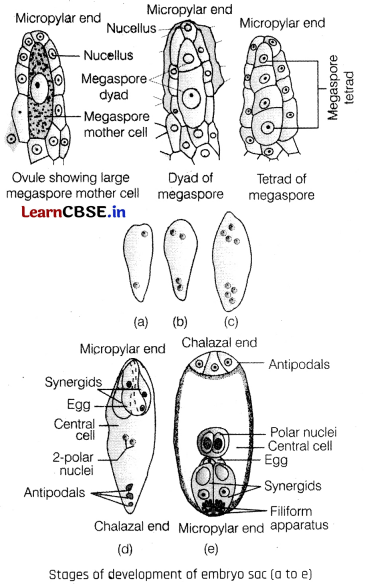
Question 29.
(i) Draw a diagrammatic sketch of a transverse section of an anther of an angiosperm. Label its different walls and the tissue forming microspore mother cells.
(ii) Describe the process of microsporogenesis up to the formation of a microspore.
(iii) Write the function of ‘germ pore’ in a pollen grain of an angiosperm. (2018C)
Answer:
Answer:
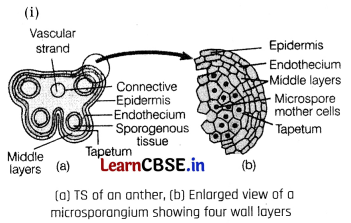
(ii) For sporogenesis, Refer to Answer No. 24.
(iii) For function of germ pore, Refer to Answer No. 18.
Question 30.
(i) Describe the sequence of the process of microsporogenesis in angiosperms.
(ii) Draw a labelled diagram of a 2-celled final structure formed. (Delhi 2015C)
Or
Trace pollen grain development from sporogenous tissue in the anther. (Delhi 2012)
Answer:
(i) Development of pollen grain from Pollen Mother Cell (PMC)
- Pollen mother cell or microspore mother cell undergoes meiosis to form microspore tetrad or haploid microspores.
- As the anther matures, the microspores dissociate from the tetrad and develop into pollen grains.
- Nucleus of the microspores undergoes mitosis to form a large vegetative cell and small spindle-shaped generative cell.
- They develop a two-layered wall, the outer exine made of sporopollenin and the inner intine made of cellulose and pectin.
- Usually the pollen grains are liberated at this 2-celled stage.
In certain species, the generative cell divides mitotically to form two male gametes and the pollen grains are 3-celled during liberation.
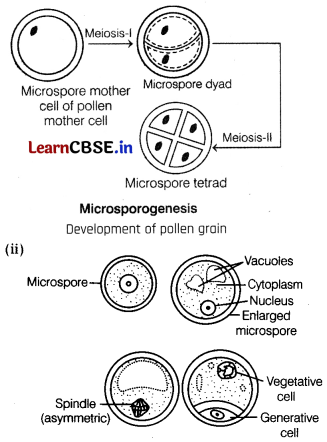
Question 31.
(i) Draw a labelled diagram of the sectional view of microsporangium of an angiosperm. (Delhi 2015)
(ii) Explain the development of male gametophyte in the microsporangium. (Delhi 2015)
Answer:
(i) Refer to Answer No. 22 for figure of microsporangium.
(ii) Refer to Answer No. 30 for development of male gametophyte.
Question 32.
(i) Describe the formation of mature female gametophyte within an ovule in angiosperms.
(ii) Describe the structure of cell that guides the pollen tube to enter the embryo sac. (All India 2014)
Answer:
(i) The functional megaspore undergoes mitosis to form 2 nuclei, which migrate to opposite poles, forming a 2-nucleate embryo sac. Further, mitotic divisions lead to the formation of 4-nucleate and 8-nucleate stages of the embryo sac. In these mitotic divisions, nuclear division is not followed by cell wall formation. After the 8-nucleate stage, cell walls are laid down and a typical female gametophyte or embryo sac is formed. Among the eight nuclei, six are enclosed by cell wall and organised into cells, while the remaining two nuclei (polar nuclei) are situated above the egg apparatus in a large central cell.
Out of the six cells, three are grouped at the micropylar end and constitute the egg apparatus made up of two synergids and one egg cell. The other three cells are located at the chalazal end and are called antipodals. Thus, a typical angiosperm embryo sac after maturity is 8-nucleate and 7-celled.
(ii) The egg apparatus present towards the micropylar end, comprises of two synergids and an egg cell.
These synergids possess special cellular thickenings at their micropylar tip and called filiform apparatus. This filiform apparatus guides the pollen tube to enter into embryo sac.
For figure. Refer to Answer No. 28 fig (e).
Question 33.
Draw a labelled diagram of sectional view of a mature embryo sac of an angiosperm. (Delhi 2014)
Answer:
Refer to figure of embryo sac in Answer No. 11.
Question 34.
How does the megaspore mother cell develop into 7-celled and 8-nucleate embryo sac in an angiosperm? Draw a labelled diagram of a mature embryo sac. (Delhi 2012)
Or
Explain with the help of diagram the development of mature embryo sac from a megaspore mother cell in angiosperm. (Foreign 2012, All India 2010C)
Or
Describe the process of megasporogenesis in angiosperm until 8-nucleate stage. (All India 2013C)
Answer:
For development of megaspore mother cell. Refer to Answer No. 32 (i).
![]()
Question 35.
(i) Draw a diagram of an enlarged view of TS of one microsporangium of an angiosperm and label the following parts
(a) Tapetum
(b) Middle layers
(c) Endothecium
(d) Microspore mother cell
(ii) Mention the characteristic features and function of tapetum.
(iii) Explain the following giving reasons
(a) Pollen grains are well-preserved as fossils.
(b) Pollen tablets are in use of people these days. (Foreign 2011)
Answer:
(i) For diagram. Refer to Answer No. 22.
(ii) Tapetum is the inner nourishing layer of microsporangial wall. The cells of tapetum have dense cytoplasm and more than one nucleus. These cells nourish the developing pollen grains.
(iii) (a) The outer exine layer of pollen grain is highly resistant because of sporopollenin. It is an organic material which can withstand harsh conditions, action of alkalis and acids. No enzyme can degrade sporopollenin. Thus, pollen grains are well-preserved as fossils.
(b) Pollen grains are rich in nutrients. So, used by people as health tablets or food supplements
Question 36.
Write one advantage and one disadvantage of cleistogamy to flowering plants. (2018C)
Answer:
The advantage of cleistogamy is that it ensures pollination in the absence of pollinators. Disadvantage of cleistogamy is that there is no chance of variation to occur.
Question 37.
What is pollen-pistil interaction and how is it mediated? (Foreign 2014)
Answer:
Pollen-pistil interaction is a chain or group of • events that take place from the falling of pollen over the stigma to the formation of pollen tube and its entry into the ovule. It is mediated by chemical components of pollen grain, interacting with that of pistil.
Question 38.
Differentiate between xenogamy and geitonogamy. (Delhi 2014C)
Answer:
Xenogamy is the transfer of pollen grains from anther of one flower to the stigma of another flower of a different plant, while geitonogamy is the transfer of pollen grains from anther of one flower to the stigma of another flower on same plant.
Question 39.
How do the pollen grains of Vallisneria protect themselves? (All India 2012)
Or
Why do the pollen grains of Vallisneria have a mucilaginous covering? (Delhi 2010)
Answer:
As the pollination of Vallisneria takes place by means of water, the pollen grains are covered by mucilaginous coating that protects them from damage and desiccation.
Question 40.
What is cleistogamy? Write one advantage and one disadvantage of it, to the plant. (All India 2019)
Answer:
Cleistogamy is a type of self-pollination that occurs in a permanently closed flower. Advantage and disadvantage of cleistogamy are as follows
- Advantage Cleistogamous flowers produce assured seed-set even in the absence of pollinators.
- Disadvantage Cleistogamous flowers are invariably autogamous. So, there is no chance of cross-pollination. Hence, less variations are generated in the progeny.
Question 41.
You are conducting artificial hybridisation on papaya and potato. Which one of them would require the step of emasculation and why ? However for both you will use the process of bagging. Justify giving one reason. (Delhi 2019)
Answer:
Papaya produces unisexual flowers and potato produces bisexual flowers. Therefore, the step of emasculation will be done on potato because emasculation is done on bisexual flower to avoid self-pollination. But, bagging is done on unisexual flowers, so to dust suitable pollen grains op the stigma when the stigma turns receptive and the flowers are rebagged.
Question 42.
Express the process of pollination in Vallisneria. (Delhi 2019)
Answer:
Vallisneria is a water pollinated plant. In this plant, the process of pollination involves reaching of female flower at the surface of water by the long stalk and release of pollen grains onto the surface of water. These pollen grains are carried water currents to reach the stigma eventually.
Question 43.
A single pea plant in your kitchen garden produces pods with viable seeds, but the individual papaya plant does not. Explain. (All India 2016)
Or
Out of mafty papaya plants growing in your garden, only a few bear fruits. Give reason.
Answer:
A single pea plant produces pods with viable seeds because the pea plant is autogamous, i.e they have the ability of self-pollination. Whereas the individual papaya plant is prevented from both autogamy and geitonogamy. In this plant, male and female flowers are present on different plants, i.e. each plant is either male or female.
Question 44.
Explain the process of pollination in Vallisneria. (Delhi 2016)
Answer:
Pollination in Vallisneria Refer to Answer No. 7.
Question 45.
List the different types of pollination depending upon the source of pollen grain. (Delhi 2016)
Or
Differentiate between autogamy, geitonogamy and xenogamy. (All India 2012)
Answer:
Depending on the source of pollen grain, pollination can be classified into
- Autogamy It is the transfer of pollen grain from anther to the stigma of the same flower.
- Geitonogamy It is the transfer of pollen grains from anther of one flower to the stigma of another flower on the same plant. Geitonogamy is functionally cross-pollination involving pollinating agent, but genetically it is equivalent to autogamy since the pollen grains come from the same plant.
- Xenogamy It is the transfer of pollen grains from anther to the stigma of different plants of same species. It brings genetically different types of pollen grains to the stigma.
Question 46.
In angiosperms, zygote is diploid, while primary endosperm cell is triploid. Explain. (All India 2013)
Or
Mention the reasons for difference in ploidy of zygote and primary endosperm nucleus in an angiosperm. (Delhi 2010)
Answer:
In angiosperms or flowering plants, zygote is diploid and primary endosperm nucleus is triploid. It is because in these plants, one of the male gametes fuses with egg cell, which results in the formation of zygote. So, zygote is diploid. While primary endosperm cell is triploid because the nucleus of the second male gamete (n) fuses with the two haploid polar nuclei or diploid secondary nucleus (2n) of the central cell to form a triploid primary endosperm nucleus (3n). This process is referred to as triple fusion. The central cell is now called primary endosperm cell.
Question 47.
Explain triple fusion in angiosperm. (Delhi 2013)
Answer:
For triple fusion. Refer to Answer No. 11.
Question 48.
State one advantage and one disadvantage of cleistogamy. (All India 2012)
Answer:
For cleistogamy. Refer to Answer No. 5.
Question 49.
Why should a bisexual flower be emasculated and bagged prior to artificial pollination? (Foreign 2010)
Or
Why does a breeder need to emasculate a bisexual flower? Mention a condition in a flower where emasculation is not necessary. (Delhi 2011)
Answer:
Emasculation in a bisexual flower is required to prevent contamination of the stigma with self-pollen grains. Bagging is done to prevent contamination of the stigma of the emasculated flower with any other unwanted pollen grains. That is why a bisexual flower should be emasculated and bagged prior to artificial pollination. Emasculation is not required in unisexual flowers.
Question 50.
(i) Draw a LS of pistil showing pollen tube entering into the embryo sac. Label the following. (All India 2019)
(a) Nucellus
(b) Antipodals
(c) Synergids
(d) Micropyle
(ii) Write the functions of the following
(a) Synergids
(b) Micropyle
Answer:
(i) For pistil-pollen diagram, Refer to Answer No. 19 (ii).
(ii) (a) Synergids These possess special cellular thickenings at their micropylar tip called filiform apparatus. This filiform apparatus guides the pollen tube to enter embryo sac.
(b) Micropyle It facilitates the entry of pollen tube and thus fertilisation.
Question 51.
Emasculation and bagging are the two important steps carried during artificial hybridisation to obtain superior varieties of desired plants. Explain giving reasons, in which types of flowers and at what stages are the two processes carried out. (All India 2019)
Answer:
For emasculation and bagging. Refer to Answer No. 14. If the plant bears bisexual flowers, emasculation and bagging are carried out before the anther dehisces.
If the plant bears unisexual flowers, emasculation is not required. The female flower buds are bagged before the opening of flowers are
| Geitonogamy | Xenogamy |
| It is the transfer of pollen grains from the anther to the stigma of another flower of same plant. | It is the transfer of pollen grains from the anther to the stigma of different plants. |
| The pollen grains are genetically similar to the plant. | The pollen grains are genetically different from the plant. |
Geitonogamy result sun progenies which are animals and even humans. It is believed that pollination by wind (anemophily) is more coihmon because transport by wind-current can take pollens to distant places.
Question 52.
(i) Differentiate between geitonogamy and xenogamy.
(ii) Write the difference in the characteristics of the progeny produced as a result of the two processes. (Delhi 2019)
Answer:
(i) Differences between geitonogamy and xenogamy purelines, e.g. homozygous. They are genetically similar. Xenogamy results in hybrids, e.g. heterozygous. They show variations in characters.
Question 53.
How does a bisexual flowering plant ensure cross-pollination ? Explain. (Delhi 2019)
Answer:
Bisexual flowers ensuring cross-pollination Refer to Answer No. 22.
![]()
Question 54.
(i) Can a plant flowering in Mumbai be pollinated by pollen grains of the same species growing in New Delhi? Provide explanation to your answer,
(ii) Draw the diagram of a pistil where pollination has successfully occurred. Label the parts involved in reaching the male gametes to its desired destination. (All India 2017)
Answer:
(i) Yes, a plant flowering in Mumbai can be pollinated by pollen grains of the same species growing in New Delhi. It is mainly because there are certain agents of pollination that can carry pollen grains to long distance. Plants can use either abiotic or biotic agents for pollination. Abiotic pollinators include wind and water while biotic pollinators are insects, birds,
(ii) The parts involved in transferring the male gametes to its desired destination are stigma, style, micropyle, filiform apparatus and synergids. Longitudinal Section (LS) of a post-pollinated pistil is given below
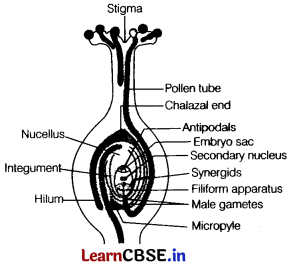
Question 55.
What does an interaction between pollen grains and its compatible stigma result in after pollination? List two steps in sequence that follow after the process. (Delhi 2016)
Answer:
When the pollen grains fall on the stigma, the pollen tube enters one of the synergids and releases two male gametes.
- One of the male gametes moves towards the egg cell and fuses with it to complete syngamy to form the zygote.
- The other male gamete fuses with the two polar nuclei and forms triploid Primary Endosperm Nucleus (PEN). This is termed as triple fusion.
- Since, two kinds of fusion syngamy and triple fusion takes place, the process is known as double fertilisation and is characteristics of flowering plants.
Question 56.
As a senior biology student you have been asked to demonstrate to the students of secondary level in your school, the procedure(s) that shall ensure cross-pollination in a hermaphrodite flower. List the different steps that you would suggest and provide reasons for each one of them. (All India 2016)
Answer:
Cross-pollination is done to mix two desired characters of two different species of a plant. For example, purple and white flower of a pea.
- Select two pea plants one with white and other with purple flower.
- Label them as male (white flowered) and female (purple flowered) plant.
- Cut anthers from purple flower with the help of scissors before their dehiscence to avoid self-pollination and cover it with white paper bag.
- Now collect pollens from the white flower (male plant) with the help of brush.
- Dust the pollens on the stigma of female (purple fewer) flower.
- Cover it again with paper bag till seed formation.
Question 57.
Flowering plants have developed many devices to discourage self-pollination and to encourage cross-pollination. Explain three such devices. Delhi 2016C
Or
Why do hermaphrodite angiosperms develop outbreeding devices? Explain any two such devices with the help of examples. (All India 2015)
Or
Make a list of any three outbreeding devices that flowering plants have developed and explain how they help to encourage cross-pollination. (All India 2014)
Answer:
Hermaphrodites or bisexual flowers develop outbreeding devices to ensure cross-pollination and avoid self-pollination. The three outbreeding devices that flowering plants have developed to discourage self-pollination are
(i) Unisexuality (Dicliny) Flowers are unisexual, so that self-pollination is not possible. The plants may be monoecious (bearing both male and female flowers, e.g. maize) or dioecious (bearing male and female flowers on different plants, e.g. mulberry, papaya).
(ii) Dichogamy Anthers and stigmas mature at different times in a bisexual flower for preventing self-pollination.
(a) Protandry Anthers mature earlier than stigma of the same flower. The pollens thus btfcome available to stigmas of the older flowers, e.g. sunflower, Salvia.
(b) Protogyny Stigmas mature earlier, so that they get pollinated before the anthers of the same flower develop pollen grains, e.g. Mirabilis jalapa,
Gloriosa, Plantago.
(iii) The third device to prevent self-pollination is self-incompatibility. It is a genetic mechanism that prevents self-pollen from fertilising the ovules by preventing pollen germination or pollen tube growth in the pistil. All these methods encourage cross-pollination thus causing genetic variations among them.
Question 58.
Explain the phenomenon of double fertilisation. (Delhi 2014)
Answer:
The phenomenon of double fertilisation occurs in following steps
- In an angiospermic plant, two male gametes are discharged by a pollen tube into the cytoplasm of a synergid of the embryo sac.
- One of the male gametes fuses with the egg to form a zygote. This process is called syngamy.
- Other male gamete fuses with the secondary nucleus to form the primary endosperm nucleus, this process is called triple fusion.
- Since, there are two fusions (syngamy and triple fusion) inside an ovule during fertilisation, it is known as double fertilisation.
Question 59.
Write the differences between wind pollinated and insect pollinated flowers. Give an example of each type. (Foreign 2014)
Answer:
The differences between wind pollinated and insect pollinated flowers are
| Wind pollinated flowers | Insect pollinated flowers |
| These are small. | They are either large or grouped to form large clusters. |
| Usually inconspicuous due to dull colours. | The presence of bright colours in corolla, calyx or bracts to attract insects. |
| They are odourless and devoid of nectar. | Strongly odoured and usually possess nectar or edible pollen. |
| Pollens are produced in large numbers. | Fewer pollen grains are produced. |
| e.g. Urtica, Maize, Parthenium. | e.g. Rose, Snapdragon, Calotropis. |
Question 60.
Differentiate between geitonogamy and xenogamy in plants. Which one between the two will led to inbreeding depression and why? (Delhi 2011)
Answer:
For difference. Refer to Answer No. 17 (i).
Geitonogamy will lead to inbreeding depression because the pollen grains are genetically similar resulting into inbreeding. Continuous inbreeding reduces fertility.
Question 61.
(i) Write the characteristic features of anther, pollen and stigma of wind pollinated flowers.
(ii) How do flowers reward their insect pollinator? Explain. (All India 2010)
Answer:
(i) In wind pollinated flowers,
- Anthers are well-exposed for easy dispersal of pollen grains.
- Pollen grains are light and non-sticky, so that they can be transported by wind currents.
- Stigma is large and feathery to trap pollens.
(ii) Flower rewards their insect pollinators easily by offering
- Nectar and edible pollen grains.
- Safe place for insects to lay eggs by some flowers, e.g. Amorphophallus and Yucca.
Question 62.
(i) Describe any two devices in a flowering plant which prevent both autogamy and geitonogamy.
(ii) Explain the events up to double fertilisation after the pollen tube enters one of the synergids in an ovule of an angiosperm. (Delhi 2011)
Answer:
(i) The two devices that prevent both autogamy and geitonogamy in flowering plants are as follows
(a) Self-incompatibility In some plants when pollen from same flower or other flower of the same plant comes on the stigma, it is incapable of bringing about fertilisation.
It is due to the presence of similar self-sterile gene, e.g. tobacco, potato, etc. It prevents autogamy and geitonogamy.
(b) Dioecy In several species such as papaya, male and female flowers are present on different plants. Thus, each plant is either male or female. This condition also prevents both autogamy and geitonogamy.
(ii) In the ovule, the pollen tube is attracted by secretions of synergids. Usually the pollen tube enters the embryo sac by passing into one of the two synergids which starts degenerating. The pollen tube bursts up by absorbing hydrolytic substances secreted by degenerating synergids. It is followed by double fertilisation in flowering plants.
Double fertilisation It is the fusion of two male gametes to two different cells of the same female gametophyte in order to produce two different structures.
Nawaschin (1898) was the first to show that both the male gametes are involved in fertilisation in Fritillaria and Lilium. Double fertilisation consists of two events that are as follows
- Syngamy or Amphimixis Fusion of the egg nucleus with one male gamete is called syngamy. This fusion results in the formation of diploid cell, the zygote.
- Triple fusion Along with syngamy, the other’male gamete moves towards the two polar nuclei located in the central cell and fuses with them to produce a triploid Primary Endosperm Mother (PEM) cell. In this way, fertilisation occurs in flowering plants.
Question 63.
Draw the longitudinal section of a flower showing growth of pollen tube up to the embryo sac. Label the following parts
(i) Stigma
(ii) Pollen tube
(iii) Integument
(iv) Chalazal end
(v) Nucellus
(vi) Synergids
Answer:
For LS of flower. Refer to Answer No. 19 (ii).
Question 64.
(i) Plan an experiment and prepare a flow chart of the steps that you would follow to ensure that the seeds are formed only from the desired sets of pollen grains. Name the type of experiment that you carried out.
(ii) Write the importance of such experiments. (All India 2015)
Answer:
(i) Artificial hybridisation is carried out to ensure that seeds are formed from the desired set of pollen grains. This is done by emasculation and bagging.
The flow chart below shows the steps to be followed
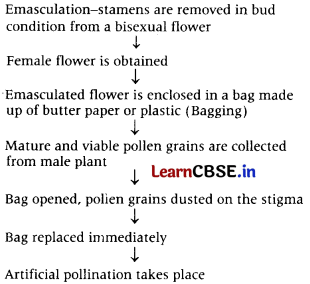
(ii) Importance of such experiments are
(a) Creation of new genetic recombination with better qualities.
(b) Incorporation of a large number of desirable characters into a single variety.
Question 65.
Angiospermic flowers may be monoecious, cleistogamous or show self-incompatibility. Describe the characteristic features of each one of them and state which one of these flowers promotes inbreeding and outbreeding, respectively. (All India 2014)
Answer:
The characteristic features of angiospermic flowers
(i) Monoecious flowers are unisexual, i.e. they have either the male reproductive or female reproductive part in separate flowers, both produced on same plant. The flowers (male and female) are separate. It prevents self¬pollination and promotes cross-pollination.
(ii) Cleistogamous flowers are those flowers in which anthers and stigmas lie close to each other and do not open at all, even at maturity. These flowers are invariably autogamous and promote inbreeding depression as there is no chance for cross-pollination at all.
(iii) Self-incompatible In angiospermic flowers, there is a genetic mechanism, wherein the flowers prevent the self-pollens from fertilising the ovules or inhibit their germination on stigma. This device or mechanism promotes outbreeding.
Question 66.
(i) Draw a longitudinal section of a pistil of an angiosperm showing the growth of pollen tube up to the micropyle of ovule. Label
(a) stigma,
(b) embryo sac
(c) pollen tube
(d) micropyle.
(ii) Explain the events that occur, up to fertilisation, when the compatible pollen grain lands on the stigma. (Delhi 2014)
Answer:
(i) For LS of flower. Refer to Answer No. 19 (ii).
(ii) The events that occur when compatible pollen grains fall on stigma in the sequence are as follows
(a) Pollen-pistil interaction Once the compatible pollen grains fall on stigma which is receptive, it recognises and accepts the pollen with the aid of chemical components interacting with pollen.
(b) Germination of pollen grain Once the pollen is recognised, it germinates on the stigma of flower. The tube cell of pollen grain protrudes out through germ pores to form a pollen tube. The generative cell divides to form two male gametes that are released into the tube.
(c) Growth of pollen tube The pollen tube grows down through the tissues of stigma and style and enters ovule, usually through micropyle. Inside ovule, the filiform apparatus guides the pollen tube, carrying gametes to the egg cell.
(d) Double fertilisation After releasing the two male gametes into the synergids, one of them fuses with egg to form a diploid zygote (syngamy) and other male gamete fuses with 2 polar nuclei to form triploid primary endosperm cell (triple fusion). Because of the occurrence of these two types of fusions, it is called double fertilisation.
![]()
Question 67.
Why is fertilisation in an angiosperm referred to as double fertilisation? Mention the ploidy of the cells involved. (All India 2012)
Answer:
In fertilisation (in angiosperm), two types of fusion occur, i.e. syngamy and triple fusion, in the embryo sac. That is why it is called double fertilisation.
Ploidy of cells involved in double fertilisation: Zygote is diploid (2n). It is formed as a result of syngamy, i.e. fusion of two haploid gametes (male gamete + egg). Primary endosperm nucleus (3M) is formed as a result of triple fusion, i.,e. fusion of two haploid polar nuclei with male gamete.
Question 68.
Draw a diagram of a fertilised embryo sac of a dicot flower. Label all its cellular components. (Delhi 2015)
Or
(i) Why is the process of fertilisation in angiosperms termed as double fertilisation? Explain.
(ii) Draw a diagram of an angiospermic embryo sac, where fertilisation is just completed.
Label the following parts
- Micropylar end of embryo sac
- The part that develops into an embryo
- The part that develops into an endosperm
- The degenerating cells at the chalazal end
(iii) Draw a labelled diagram of globular embryonic stage of an angiosperm. (Foreign 2011)
Answer:
(i) Refer to Answer No. 31 (d) for double fertilisation.
(ii) Fertilised angiospermic embryo sac with its cellular component is given below
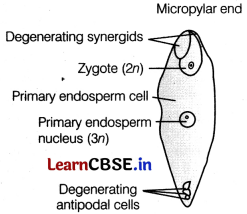
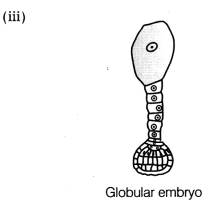
Question 69.
(i) Geitonogamy is functionally a cross-pollination, but genetically similar to autogamy. Explain.
(ii) Why do flowering plants need to develop outbreeding devices? Explain any three such devices developed by flowering plants. (All India 2010)
Answer:
(i) Transfer of pollen grains from the anther to stigma of another flower of the same plant is called geitonogamy. It is functionally cross-pollination as it involves a pollinating agent, but genetically similar to autogamy since, the pollen grains come from the same plant (genetically same parent).
(ii) Continued self-pollination results in inbreeding depression because majority of flowering plants produce hermaphrodite flowers and pollen grains generally come in contact with the stigma of same flower.
(iii) To discourage this, flowering plants developed many devices. For some of these devices, Refer to Answer No. 22.
Question 70.
Given below is a section of maize grain. Identify A and state its function.
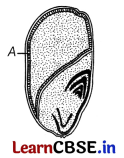
Answer:
A is endosperm. It provides nutrition to the developing embryo.
Question 71.
Identify A in the figure showing a stage of embryo development in a dicot plant and mention its function. (All India 2016)
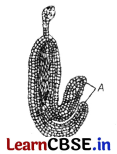
Answer:
A is cotyledon. It is the storehouse of food.
Question 72.
Mention the function of coleorhiza. (Delhi 2015C, All India 2012)
Answer:
Coleorhiza is a protective sheath covering the young root of the embryo in plants of the grass family.
Question 73.
The meiocyte of rice has 24 chromosomes. Write the number of chromosomes in its endosperm. (All India 2013)
Answer:
The meiocyte is a diploid cell and have 24 chromosomes. Thus, its haploid chromosome number is 12.
Number of chromosomes in endosperm is
12 × 3 = 36
Question 74.
Write the function of scutellum. (Delhi 2012)
Answer:
The cotyledon of embryo of grass family is called scutellum. It is an embryonic leaf.
Question 75.
Banana is a true fruit but is also a parthenocarpic fruit. Give reason. (Foreign 2010C)
Or
Why is banana referred to as a parthenocarpic fruit? (All India 2013)
Or
Why is banana considered a good example of parthenocarpy? (All India 2012)
Answer:
The fruit of banana is formed from the ovary, so it is a true fruit. It is a parthenocarpic fruit because the ovary develops into fruit without fertilisation and is thus seedless.
Question 76.
Why is apple referred to as a false fruit? (All India 2010C)
Answer:
In apple, the thalamus also contributes to fruit formation. So, apples are called false fruits.
Question 77.
Name the mechanism responsible for the formation of seed without fertilisation in angiosperms. Give an example of a species of flowering plants with such seed formation. (Delhi 2010)
Answer:
Apomixis is the mechanism responsible for the formation of seeds without fertilisation in angiosperms, e.g. grasses.
Question 78.
It is said apomixis is a type of asexual reproduction. Justify. (Delhi 2019)
Answer:
Through apomixis, viable seeds can be produced without fertilisation and zygote formation through gametic fusion. This is not the case during sexual reproduction. In sexual reproduction, seeds are produced through gametic fusion following fertilisation. So, apomixis is called a type of asexual reproduction.
Question 79.
Name the type of fruit apple is categorised under and why? Mention two other examples which belong to the same category as apple. (Delhi 2015C)
Answer:
Apple is categorised as false fruit because it does not develop from the ovary, but thalamus. Cashew and strawberry belong to the same category as apple.
Question 80.
Write the difference between the tender coconut water and the thick, white kernel of a mature coconut and their ploidy. (Delhi 2015C)
Answer:
The tender coconut water represents the free nuclear endosperm while, the white kernel is the cellular endosperm. The water and kernel of the endosperm are both triploid.
Question 81.
Suggest two advantages to a farmer using apomictic seeds of hybrid varieties.(Foreign 2015)
Answer:
Two advantages of apomictic seeds to a farmer are as follows
- It lowers the cost of production.
- Apomictic seeds do not have to be produced every year.
Question 82.
List the post-fertilisation events in angiosperms. (Delhi 2014)
Answer:
The post-fertilisation events in angiosperms include
- Endosperm and embryo development.
- Maturation of ovule into seed.
- Maturation of ovary into fruit.
Question 83.
Draw a labelled diagram of a matured embryo of a dicotyledonous plant. (All India 2014C)
Answer:
The labelled diagram of a mature embryo of a dicotyledonous plant is as given below
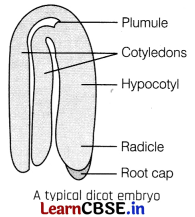
Question 84.
Write the fate of egg cell and polar nuclei after fertilisation. (Delhi 2013)
Or
Write the fate of triple fusion in mature fruit of coconut. (Delhi 2012)
Answer:
The egg cell after fertilisation with one of the two male nuclei forms zygote which further develops into an embryo. Polar nuclei fuse with other male nuclei to form primary endosperm nucleus which further develops into endosperm. In case of coconut, the endosperm is watery.
Question 85.
Some angiospermic seeds are said to be ‘albuminous’, whereas few others are said to have a perisperm. Explain each with the help of an example. (Foreign 2012)
Answer:
Some angiospermic seeds are albuminous as they retain endosperm even after embryo development, i.e. not completely consumed by embryo, e.g. wheat, maize, castor. nucellus are persistent which is referred to as perisperm, e.g. black pepper and beet.
Question 86.
Differentiate between albuminous and non-albuminous seeds, giving one example of each. (Delhi 2011)
Answer:
Difference between albuminous and non-albuminous seeds is Albuminous seed
| Albuminous seed | Non-albuminous seed |
| Endosperm is not completely consumed by the developing embryo, so a portion of it remains in the seed. | Endosperm is completely consumed by the developing embryo before the maturation of seed, so there is no endosperm left in the seed. |
| e.g. coconut, castor and maize. | e.g. pea, bean and mustard. |
Question 87.
(i) Given below is a TS of an apple.
(ii) Why is an apple categorised as a false fruit?
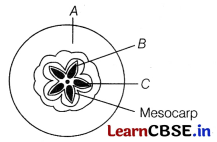
Answer:
(i) In the given figure of TS of an apple,
A – Thalamus, B – Seed, C – Endocarp
(ii) For false fruit, Refer to Answer No. 7.
Question 88.
State what is apomixis? Write its significance. How can it be commercially used? (All India 2019)
Answer:
For apomixis, Refer to Answer No. 24.
Question 89.
Differentiate between parthenocarpy and parthenogenesis. Give one example of each. (2018C)
Answer:
The differences between parthenocarpy and parthenogenesis are
| Parthenocarpy | Parthenogenesis |
| It is the phenomenon of formation of fruits, without fertilisation. | It is the phenomenon in which the unfertilised female gamete (ovum) develops into an adult. |
| It occurs in plants only. | It occurs in plants and animals both. |
| Fruits produced by this procedure are of normal type. e.g. Pineapple fruits. | Individuals produced by parthenocarpy are usually weak or non-viable, e.g. Plants-Datura, Animals- drones (honeybee). |
Question 90.
If the meiocyte of a maize plant contains 20 chromosomes. Write the number of chromosomes in the endosperm and embyro of the maize grain and give reasons in support of your answer. (2018C)
Answer:
If the meiocyte of a maize plant contains 20 chromosomes, then the number of chromosomes in the endosperm and the embryo of maize grain will be 30 and 20, respectively.
The meiocyte is a diploid cell and have 20 chromosomes. Thus, its haploid chromosome is 10.
Number of chromosome in endosperm is 10 × 3 = 30.
Number of chromosomes in embryo is 2n,
2 × 10 = 20.
Question 91.
Do you think apomixis can be compared with asexual reproduction? Support your answer, giving one reason. How is apomixis beneficial to farmers? Explain. (2018 C)
Answer:
Yes, apomixis can be compared with asexual reproduction. It is also called a form of asexual reproduction that mimics sexual reproduction.
In apomixis, seeds are produced without fertilisation and zygote formation through gametic fusion. So, it can be called as a form of asexual reproduction.
Two advantages of apomictic seeds (apomixis) to farmers are
- It lowers the cost of production.
- Apomictic seeds do not have to be produced every year.
Question 92.
How are parthenocarpic fruits produced by some plants and apomictic seeds by some other? Explain. (Delhi 2016)
Answer:
Parthenocarpic Seeds:
Some fruits develop without undergoing fertilisation, these are called parthenocarpic fruits, e.g. banana and this process of formation of fruit without fertilisation is called parthenocarpy. It can be induced through the application of growth hormones and such fruits are seedless.
Apomictic Seeds:
It is a form of asexual reproduction that mimics sexual reproduction, but produces viable seeds without fertilisation. It does not involve formation of zygote through the gametic fusion. It occurs in some species of Asteraceae and grasses.
These are produced from segments of fruit (mango stem), male gametic content of pollen (Cyperus) and other vegetative parts. In some species, the diploid egg cell is formed without reduction division and develops into embryo without fertilisation. It is an asexual reproduction in the absence of pollinators and takes place in extreme environments.
In some species like Citrus, some of the nucellar cells surrounding the embryo sac start dividing and develop into embryo. It occurs in the megaspore mother cell that does not undergo meiosis, thus produces diploid embryo sac through mitotic divisions.
Farmers pick apomictic seeds in plants which do not reproduce sexually. So that farmers use this method for the production of cloned seed.
![]()
Question 93.
State what is apomixis. Comment on its significance. How can it be commercially used? (All India 2015)
Answer:
Apomixis is the special mechanism to produce seeds without fertilisation. It is a form of asexual reproduction that mimics sexual reproduction.
Significance:
-
It helps in fixing heterosis or hybrid vigour in plants permanently.
Rapid multiplication of genetically uniform individuals can be achieved without risk of segregation.
Commercial use Apomixis is used in plant breeding. It increases the chance of developing superior gene combinations and facilitates the rapid incorporation of desirable traits.
Question 94.
Double fertilisation is reported in plants of both, castor and groundnut. However, the mature seeds of groundnut are non-albuminous and castor are albuminous. Explain the post-fertilisation events that are responsible for it. (Delhi 2015)
Answer:
Double fertilisation is reported in both castor and
groundnut, but their mature seeds are different in terms of endosperm. The primary endosperm nucleus formed after fertilisation divides mitotically without cytokinesis to initiate the formation of endosperm. At this stage, the endosperm is called free nuclear endosperm.
Then, cell wall formation occurs and the endosperm becomes cellular type. The number of free nuclei formed before cellularisation varies greatly. Endosperm may be completely utilised by the developing embryo before the maturation of seeds as in groundnut. Such seeds are called non-albuminous or non-endospermic seeds.
When a portion of endosperm remains in seeds and is used up during seed germination, such seeds are called albuminous or endospermic seeds, e.g. castor.
Question 95.
Describe endosperm development in angiosperm. Foreign (2014)
Answer:
Endosperm development takes place by three methods
(i) In nuclear type, which is a common method, the Primary Endosperm Nucleus (PEN) undergoes repeated mitotic division without cytokinesis. At this stage, the endosperm is called free nuclear endosperm.
(ii) In cellular type, cell wall formation occurs and the endosperm becomes cellular. The number of free nuclei formed before cellularisation varies greatly, e.g. in coconut, the water is free nuclear endosperm and surrounding white kernel is cellular endosperm.
(iii) In helobial type endosperm formation, one half of endosperm is nuclear type and other half is cellular type.
Question 96.
(i) How is apomixis different from parthenocarpy?
(ii) Describe any two modes by which apomictic seeds can be produced. (Delhi 2014C)
Answer:
(i) Parthenocarpy is the development and production of seedless fruits in the absence of fertilisation, whereas apomixis refers to development of seeds and fruits, without fertilisation. So, the main difference between apomixis and parthenocarpy is that seeds are formed in former, while absent in later.
(ii) The two modes by which apomictic seeds can be produced are
(a) Agamospermy in which the seed or embryo is derived from diploid egg cell, formed without meiosis and syngamy. This diploid egg cell develops into embryo without undergoing fertilisation, e.g. apple, Rubus.
(b) Adventive embryony The method in which diploid cells surrounding the embryo sac, e.g nucellus and integument protrude into the sac and develop into embryo. This may also lead to the formation of more than one embryos in an embryo sac or ovule, leading to condition called polyembryony, e.g. Citrus, Opuntia.
Question 97.
Differentiate between parthenogenesis and parthenocarpy. (All India 2014C)
Answer:
For Parthenocarpy and Parthenogenesis, Refer to Answer No. 20.
Question 98.
(i) Describe the endosperm development in coconut.
(ii) Why is tender coconut considered as healthy source of nutrition?
(iii) How are pea seeds different from castor seeds with respect to endosperm? (All India 2013)
Answer:
(i) Coconut endosperm formation is nuclear type.
The primary endosperm nucleus undergoes free nuclear division without cell wall formation.
(ii) Soft coconut is an endosperm. It is rich in nutrients like fats, proteins, carbohydrates, minerals, vitamins, etc. Hence, it is considered as a healthy source of nutrition. [1)
(iii) The seeds of pea are non-endospermic, while castor seeds are endospermic. The endosperm in pea seeds is consumed completely during embryo development, but endosperm is not utilised in castor seeds.
Question 99.
Differentiate between perisperm and endosperm giving one example of each. (All India 2012)
Answer:
Differences between perisperm and endosperm are
| Perisperm | Endosperm |
| It represents persistent remains of nucellus (of ovule) in the seed. | It develops from Primary Endosperm Nucleus (PEN). |
| It is a part that belongs to seed. | It contains reserve food materials for developing seed. |
| It is usually dry. | It is usually in fluid form or soft. |
| e.g. black pepper. | e.g. water of coconut. |
Question 100.
LS of a maize grain is given below. Label the parts A, B, C and D in it. (All India 2012)
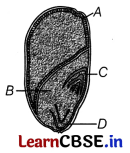
Answer:
A-Pericarp
B – Scutellum (cotyledon)
C – Coleoptile
D – Coleorhiza
Question 101.
With the help of an example of each explain the following Apomixis, Parthenocarpy, Polyembryony. (India 2012C)
Answer:
Apomixis The phenomenon in which seeds are produced without fertilisation is called apomixis or agamqspermy, e.g. grass.
Parthenocarpy It is a commercially important process in which seedless fruit is formed without fertilisation, e.g. banana.
Polyembryony The occurrence of more than one embryo in a seed is known as polyembryony, e.g. orange.
![]()
Question 102.
(i) Explain any two ways by which apomictic seed can develop.
(ii) List one advantage and one disadvantage of an apomictic crop.
(iii) Why do farmers find production of hybrid seeds costly? (Delhi 2019)
Answer:
(i) Apomictic seed can develop in two ways as follows
(a) These are produced from segments of fruit (mango stem), male gametic content of pollen (Cyperus) and other vegetative parts.
(b) In some species, the diploid egg cell is formed without reduction division and develops into embryo without fertilisation.
(ii) Advantage of apomictic crop These are the products of asexual reproduction in the absence of pollinators and takes place in extreme environment.
Disadvantage of apomictic crop During the production of apomictic crop, there is no segregation of characters in the hybrid progeny.
(iii) Apomixis produces hybrid seeds and it is a costly process. Since, hybrid seeds do not maintain hybrid characters, the apomictic seeds are to be produced year after year. This is the reason why farmers find production of hybrid seeds costly.
Question 103.
(i) When a seed of an orange is squeezed, many embryos, instead of one are observed. Explain, how it is possible.
(ii) Are these embryos genetically similar or different? Comment. (India 2017)
Answer:
(i) It is true that when we squeeze a seed of an orange, many embryos, instead of one are observed. It occurs mainly due to a process named polyembryony. It is a phenomenon of occurrence of more than one embryo in a seed. It was first described by Antony van Leeuwenhoek (1719) in Citrus. Polyembryony can be spontaneous or induced experimentally. The polyembryony may arise by the following reasons Formation of additional embryos from synergids or from antipodals and polar nuclei (very rare). Some embryos can also be derived by the activation of some sporophytic cells of ovule such as nucellus or integument.
Embryos can also be developed from an additional embryo sac in the same ovule.
(ii) The embryos formed as a result of polyembryony are genetically similar to one another. However, the embryos arising from gametophytic tissues are similar to each other, but not to their parents.
The embryos that are derived from sporophytic tissues are usually similar to each certain amount of endosperm is formed. It is an other as well as their parents.
Question 104.
(i) Explain the different ways apomictic seeds can develop. Give an example of each.
(ii) Mention one advantage of apomictic seeds to farmers.
(iii) Draw a labelled mature stage of a dicotyledonous embryo. (All India 2014)
Answer:
(i) For apomictic seeds, Refer to Answer No. 27 (ii)
(ii) For advantage of apomictic seeds, Refer to Answer No. 12.
(iii) For diagram. Refer to Answer No. 14.
Question 105.
(i) Why does endosperm development precede embryo development in angiosperm seeds? State the role of endosperm in mature albuminous seeds.
(ii) Describe with the help of three labelled diagrams of the different embryonic stages that include mature embryo of dicot plants. (Delhi 2014)
Answer:
(i) The embryo development starts only after a adaptation for assured nutrition of the developing embryo therefore, endosperm development precedes embryo development. The role of endosperm in mature albuminous seeds is storage of reserve food for growing embryo.
(ii) The embryonic stages during the development of mature embryo sac.
For figure. Refer to Answer No. 5 in Miscellaneous section on page no. 44.
Question 106.
(i) Mature seeds of legumes are non-albuminous. Then, can it be assumed that double fertilisation does not occur in legumes? Explain your answer.
(ii) List the differences between the embryos of dicot (pea) and monocot (grass) families. (Delhi 2014C)
Answer:
(i) Seeds of legumes are non-albuminous that implies that endosperm in such seeds is completely used up in providing nutrition to developing embryo. The endosperm is formed as a result of triploid fusion, i.e. between a male gamete and two polar nuclei. This makes it obvious that it cannot be formed in the absence of double fertilisation.
Therefore, though the seeds of legumes are non-albuminous, it clearly states the occurrence of double fertilisation in them.
(ii) The differences between the embryos of pea and grass can be summarised as follows
| Dicot embryo (Pea) | Monocot embryo (Grass) |
| The basal cell forms a 6-10 celled suspension. | Basal cell produces a single-celled suspension. |
| Terminal cell produces embryo, except the radicle. | Forms the whole of embryo. |
| First division of terminal cell is longitudinal. | First division is transverse. |
| It possesses two cotyledons. | It possesses one cotyledon. |
| Plumule is terminal and is present between the elongated cotyledons. | Plumule is laterally present to excessive growth of single cotyledon. |
Question 107.
(i) Why are seeds of some grasses called apomictic? Explain.
(ii) State two reasons to convince a farmer to use an apomictic crop. (Delhi 2014C)
Answer:
(i) The seeds of some grasses develop without fertilisation. It may be because a diploid egg cell develops into an embryo directly (without undergoing meiosis and syngamy) or some diploid cells of nucellus or integument surrounding the embryo sac, protrude inside and develop into embryos. This phenomenon of developing embryo and seeds without fertilisation is called apomixis and such seeds produced are referred to as apomictic.
(ii) For advantage of apomictic seeds. Refer to Answer No. 12.
Question 108.
Give reasons why?
(i) Most zygotes in angiosperms divide only after certain amount of endosperm is formed.
(ii) Groundnut seeds are exalbuminous and castor seeds are albuminous.
(iii) Micropyle remains as a small pore in the seed coat of a seed.
(iv) Integuments of an ovule hardens and the water content is highly reduced as the seed matures.
(v) Apple and cashewnuts are not called true fruits. (All India 2011)
Answer:
(i) Zygotes in angiosperms mostly divide only after a certain amount of endosperm is formed as an adaptation strategy to assure nutrition for the developing embryo.
(ii) Groundnut seeds are exalbuminous because the developing embryo utilises the endosperm completely. So, there is no endosperm left in the seed.
Castor seeds are albuminous because endosperm is not completely used up by the developing embryo. There is some amount of endosperm left in the seeds always.
(iii) Micropyle allows the entry of water and oxygen during seed germination.
(iv) During unfavourable conditions, seeds become dormant. The loss of water reduces the metabolic activity of seeds and hardens the integuments.
(v) In these fruits, thalamus contributes in fruit formation. So, they are not called true fruits.
Question 109.
(i) Draw a labelled longitudinal view of an albuminous seed.
(ii) How are seeds advantageous to flowering plants? (All India 2010)
Answer:
(i) LS of an albuminous seed (caster) is
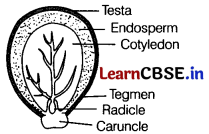
(ii) Advantages of seeds to flowering plants are
- Provide protection to embryo in most delicate stage.
- Help in dispersal and spread in new habitats.
- Contain sufficient food reserves.
- Produce genetic variations.
- Seeds are related to pollination and fertilisation.
Question 110.
Explain the development of the zygote into an embryo and of the primary endospermic nucleus into an endosperm in a fertilised embryo sac of a dicot plant.
Answer:
Development of Endosperm
Refer to Answer No. 26.
Embryo Development in Dicot Seed
- Embryo formation starts after a certain amount of endosperm is formed.
- Zygote divides by mitosis to form a proembryo.
- Formation of globular and heart-shaped embryo occurs, which finally becomes horseshoe-shaped mature embryo.
- In dicot plant, embryo consists of two cotyledons and an embryonal axis between them.
- The portion of embryonal axis above the level of attachment of cotyledons is epicotyl and terminates in the plumule.
- The portion of embryonal axis below the level of attachment of cotyledon is the hypocotyl, it becomes radicle (root tip).
Question 111.
Normally one embryo develops in one seed but when an orange seed is squeezed many embryos of different shape and size are seen. Mention how it has happened. (Delhi 2011)
Answer:
In orange seed, embryos originate by adventive embryony from diploid cells of nucellus or integuments and thus if orange seed is squeezed, many embryos of different sizes can be observed.
![]()
Question 112.
Name two end products of double fertilisation in angiosperms. How are they formed? Write their fate during the development of seed. (Delhi 2014C)
Answer:
The two end products of double fertilisation in angiosperms are diploid zygote and a triploid Primary Endosperm Nucleus (PEN).
Diploid zygote is formed by the fusion of haploid gametes, i.e. male gamete and egg, while another male gamete and two polar nuclei of central cell fuse to form triploid primary endosperm nucleus.
During the development of seed, the zygote undergoes mitotic divisions to form a mature embryo while, the primary endosperm cell gives rise to nutritive tissue called endosperm, which provides nourishment to growing embryo.
Question 113.
(i) Explain the process of double fertilisation in angiosperms.
(ii) Why does the development of endosperm precedes that of embryo?
(iii) List the parts of a typical dicot embryo.
Answer:
(i) Double fertilisation After releasing the two male gametes into the synergids from a pollen tube, one of them fuses with egg to form a diploid zygote (syngamy) and other male gamete fuses with 2 polar nuclei to form triploid primary endosperm cell (triple fusion). Because of the occurrence of these two types of fusions this process is called double fertilisation.
Refer to figure in Answer No 19. (ii) in Topic 2.
(ii) The embryo development starts only after a certain amount of endosperm is formed. It is an adaptation to assure availability of nutrition for the developing embryo.
Therefore, endosperm development precedes embryo development.
The role of endosperm in mature albuminous seeds is storage of reserve food for growing embryo.
(iii) Parts of a typical dicot embryo are
(a) Plumule (b) Radicle (c) Cotyledons (d) Hypocotyl
Question 114.
Read the following statement and answer the questions that follows.
‘A guaVa fruit has 200 viable seeds’.
(i) What are viable seeds?
(ii) Write the total number of
(a) Pollen grains
(b) Gametes are producing 200 viable guava seeds.
(iii) Prepare a flow chart to depict the post-pollination events leading to viable seed production in a flowering plant. (Delhi 2017)
Answer:
(i) Viable seeds are seeds having the ability to germinate when favourable conditions are present.
(ii) (a) Number of pollen grains = 200
(b) Gametes are producing 200 viable guava seeds = 400
(iii) Post-pollination events include
(a) Double fertilisation (b) Formation of embryo (c) Formation of endosperm
Flow chart depicting post-pollination events is as follows
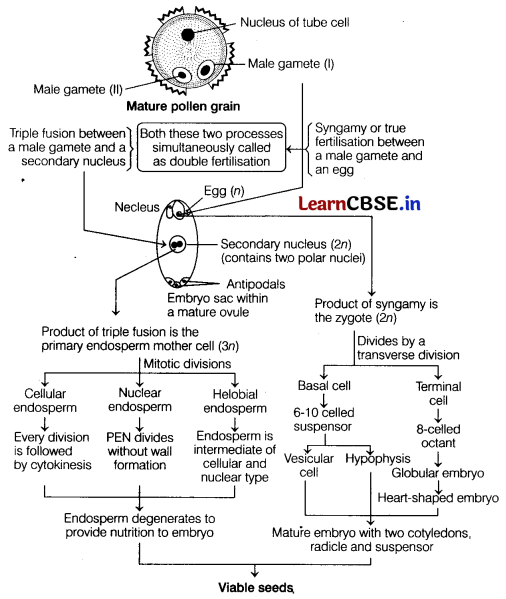
Question 115.
Read the statement and answer the questions that follows
A flower of brinjal has 520 ovules in its ovary. However, it produces a fruit with only 480 viable seeds.
(i) What could have prevented the rest of the 40 ovules from maturing into viable seeds? Explain giving a reason.
(ii) Describe the development of a dicot embryo in a viable seed.
(iii) Why certain angiospermic seeds are albuminous, while others are exalbuminous? Explain. (Delhi 2017)
Answer:
(i) Ovules can develop into viable seeds having the ability to germinate under suitable environmental conditions, however, often ovules do not develop in viable seeds because of the following reasons
- Excessive dry weather or high temperature.
- Damage to embryo.
- Starvation due to exhaustion of food in ovule.
(ii) For development of a dicot embryo. Refer to Answer No. 41 in Topic 3.
The embryonic stages during the development of a mature embryo sac are
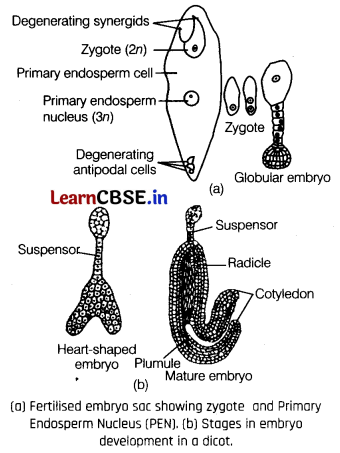
(iii) In flowering plants, during the development of seeds, along with embryo, a nutritive tissue called endosperm is also formed. During embryo development, endosperm degenerates to release its content that helps in the growth of embryo. In some plants, the endosperm is completely used up in embryo development.
In such seed, endosperm is absent, e.g. pea, gram, beans, etc. These seeds are called exalbuminous seeds. On the other hand, in some plants, the endosperm tissue persists in the viable seeds. These are called as albuminous seeds, e.g. castor.
Question 116.
(i) Explain the post-pollination events leading to seed production in angiosperms.
(ii) List the different types of pollination depending upon the source of pollen grain. (Delhi 2016)
Answer:
(i) Post-pollination events include pollen-pistil interaction, double fertilisation, formation of endosperm, development of embryo, seed and fruit.
For pollen-pistil interaction. Refer to Answer No. 2 of Topic 2.
For double fertilisation, Refer to Answer No. 23 of Topic 2.
Development of an endosperm Endosperm development precedes embryo development. The primary endosperm cell divides repeatedly to form a triploid endosperm tissue.
In most of the cases, the PEN undergoes successive nuclear divisions without cytokinesis, to give rise to free nuclear endosperm. Subsequently, cell wall formation starts from the periphery and the endosperm becomes completely cellular, e.g. coconut, rice, maize, sunflower, etc.
For figure. Refer to Answer No. 4 in Miscellaneous. Development of an embryo Embryo develops at the micropylar end of the embryo sac where the zygote is situated. Most zygotes divide only after certain amount of endosperm is formed.
The nutrition for the development of embryo is provided by the endosperm. The zygote gives rise to proembryo and subsequently to the globular, heart-shaped and mature embryo. Development of a seed Double fertilisation in angiosperms triggers the transformation of ovule into a seed. Seeds are formed inside the fruits. Formation of a fruit A fruit is formed as a result of cell division and differentiation in the ovary, which is transformed into fruit as a result of stimuli received from pollination as well as from developing seed.
(ii) Depending upon the source of pollen grains, pollination is of following three types
(a) Autogamy (Self-pollination) It is the kind of pollination achieved within the same flower. The pollen from the anthers of a flower is transferred to the stigma of the same flower, e.g. wheat, rice, pea, etc.
Autogamy is further classified as
-
Cleistogamy In some plants, flowers never open up and the anthers dehisce inside the closed flowers to ensure pollination.
Thus, cleistogamous flowers are invariably autogamous as there is no chance of cross-pollination. These flowers produce assured seed sets even in the absence of pollinators, e.g. Oxalis, Viola, etc. - Homogamy In this method, both the anthers and the stigma of bisexual flowers mature at the same time, e.g. Mirabilis.
(b) Geitonogamy The pollination where the pollen grains from the anther of a flower are transferred to the stigma of another flower borne on the same plant but at different branches. It usually occurs in plants, which show monoecious condition, e.g. Cucurbita. It is functionally cross-pollination (involves a pollinating agent) but genetically it is similar to autogamy (since pollen grains come from same plant).
(c) Xenogamy (Cross-pollination) It involves the transfer of pollen grains from the anther of one plant to the stigma of another plant. This is the only type of pollination, which brings genetically different types of pollen grains to the stigma during pollination, e.g. papaya, maize, etc.
Question 117.
(i) Explain the events after pollination leading to the formation of a seed in angiosperms.
(ii) Mention the ploidy levels of the cells of different parts of an albuminous seed. (Foreign 2015)
Answer:
(i) The following events take place between pollination and formation of a seed in angiosperms
(a) Double fertilisation
Refer to Answer No. 23 of Topic 2.
(b) Endosperm formation
Refer.to Answer No. 6 (i) of this section only.
(c) Embryo development
Refer to Answer No. 6 (i) of this section only.
(d) Seed formation Seeds are fertilised ovule that are developed inside a fruit. Each seed consists of a seed coat, an embryonal axis and cotyledon.
(ii) The ploidy of the endosperm of an albuminous seed is 3rt and ploidy of the embryo is 2n.
![]()
Question 118.
A flower of tomato plant following the process of sexual reproduction produces 240 viable seeds.
Answer the following questions giving reasons
(i) What would have been the minimum number of ovules present in per pollinated pistil?
(ii) How many microspore mother cells would minimally be required to produce requisite number of pollen grains?
(iii) How many pollen grains must have minimally pollinated the carpel?
(iv) How many male gametes would have used to produce these 200 viable seeds?
(v) How many megaspore mother cells were required in this process? (Delhi 2015)
Answer:
(i) The minimum number of ovules would also have been 240, as 240 viable seeds are formed. After fertilisation, the ovule turns into seeds.
(ii) The minimum number of microspore mother cells in the above case would be 60. This is because each microspore mother cell gives rise to 4 microspores.
Thus, to obtain 240, 60 cells are required.
(iii) The minimum number of pollen grains that must have been involved are 240, as 240 viable seeds are formed. This is because each pollen grain contains 2 male gametes, out of which one fuses with the egg forming zygote that gives rise to seeds.
(iv) The number of male gametes involved would be 240. Each male gamete fuses with one egg nucleus to form zygote that gives rise to seed.
(v) 240 megaspore mother cells were involved. They undergo meiotic division to form 4 haploid megaspores. Out of them, only 1 becomes functional megaspore, rest 3 degenerate.
Question 119.
A flower of brinjal plant following the process of sexual reproduction produces 300 viable seeds.
Answer the following questions giving reasons
(i) How many ovules are minimally involved?
(ii) How many megaspore mother cells are involved?
(iii) What is the minimum number of pollen grains that must land on stigma for pollination?
(iv) How many male gametes are involved in the above case?
(v) How many microspore mother cells must have undergone reduction division prior to dehiscence of anther in the above case? (Delhi 2015)
Answer:
(i) The minimum number of ovules would be 300 as 300 viable seeds are formed.
(ii) 300 megaspore mother cells were involved.
(iii) The minimum number of pollen grains that must have been involved are 300.
(iv) The number of male gametes involved in seed formation are 300.
(v) Minimum 75 microspore mother cells.must have been involved to form 300 pollen grains.
Question 120.
(i) Draw a LS of a pistil showing pollen tube entering the embryo sac in an angiosperm and label the six parts other than stigma, style and ovary.
(ii) Write the changes a fertilised ovule undergoes within the ovary in an angiosperm plant. (All India 2013)
Answer:
(i) Diagram Refer to Answer No. 19 (ii) of Topic 2.
(ii) Changes taking place in a fertilised ovule within the ovary in an angiospermic plant are
Fertilised ovule – Seed
Funiculus – Stalk of ovule
Integument – Seed coat
(a) outer – Testa
(b) inner – Tegman
Polar nuclei – Endosperm
Nucellus – Utilised or remaining perisperm
Antipodal – Degenerate
Synergid – Degenerate
Egg – Embryo
Question 121.
(i) Name the structures which the parts A and B shown in the diagram given below, respectively develop into.
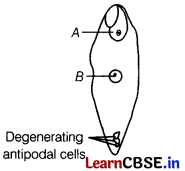
(ii) Explain the process of development which B undergoes in albuminous and exalbuminous seeds. Give one example of each of these seeds. (Foreign 2011)
Answer:
(i) The part A is zygote which develops into the embryo. The part B is primary endosperm nucleus which develops into the endosperm.
(ii) Endosperm Formation
- Primary endosperm cell divides repeatedly and forms triploid endosperm nucleus.
- Primary endosperm nucleus undergoes successive free nuclear divisions to give rise to a number of free nuclei. At this stage, it is called free nuclear endosperm.
- Wall formation takes place from the periphery and proceeds towards the centre and the endosperm becomes cellular.
- In albuminous seeds, some amount of endosperm persists in the mature seed as the developing embryo does not consume it completely, e.g. wheat, maize.
- In exalbuminous seeds, the endosperm is completely consumed by the developing embryo before seed maturation, e.g. in pea/groundnut.
Question 122.
(i) Draw a labelled diagram of LS of an embryo of grass (any six labels).
(ii) Give reason for each of the following
(a) Anthers of angiosperm flowers are described as dithecous.
(b) Hybrid seeds have to be produced year after year. (All India 2011)
Answer:
(i) LS of grass embryo is given below
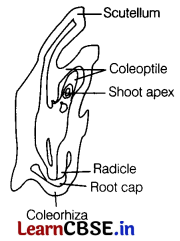
(ii) (a) A typical angiosperm anther is bilobed with each lobe having two thecae.
So, anther is called dithecous.
(b) Hybrid seeds show segregation of traits and do not maintain the hybrid character in plants. So, they need to be produced every year and cannot be stored.
Question 123.
Explain double fertilisation and trace the post-fertilisation events in sequential order leading to seed formation in a typical dicotyledonous plant. (Foreign 2010)
Answer:
For double fertilisation. Refer to Answer No. 23 of Topic 2.
Post-fertilisation events can be traced as
- Development of endosperm, enlargement of seeds and fruit formation.
- Zygote develops into an embryo.
- Central cell becomes primary endosperm cell and the primary endosperm nucleus develops into the endosperm.
- Antipodals and synergids degenerate.
- Integuments develop into seed coat.
- Ovules ripen into seeds.
- Ovary ripens to form the fruit.
For development of embryo, Refer to Answer No. 6 (i) of this section only.
Question 124.
In a group discussion during laboratory class, the process of seed formation in flowering plants was being discussed. One student pointed out that pollination is major step involved in seed formation. Another student asked how does pollination occur in plants present in water. The teacher explained the process of pollination to solve their queries.
(i) What is pollination? Give the different types of pollination.
(ii) How do flowers present submerged in water bodies adapt themselves for pollination?
Answer:
(i) The transfer of pollen grains from the anther of the stamen to the receptive stigma of a flower is called pollination. It is of two types, self-pollination and cross-pollination.
(ii) In submerged plants, the pollen grains are released in water. In such plants, pollen grains are long, ribbon-like and are carried passively inside the water to stigma for pollination.
![]()
Question 125.
A biology student Ashu, read an article on apple being a false fruit. He asked his teacher about how a fruit can be called false and was explained about the development of fruits.
(i) What are false fruits? Give an example.
(ii) What is meant by parthenocarpy?
Name a fruit develops by this method.
(iii) What are the values shown by Ashu?
Answer:
(i) The fruit derived from ovary along with other accessory floral parts like thalamus is called false fruit, e.g. apple, strawberry, etc.
(ii) In parthenocarpy, fruits develop without undergoing fertilisation. Such fruits are seedless and called as parthenocarpic fruits, e.g. banana.
(iii) Ashu is intelligent, observant, inquisitive bo9857y who is curious about new developments around him.